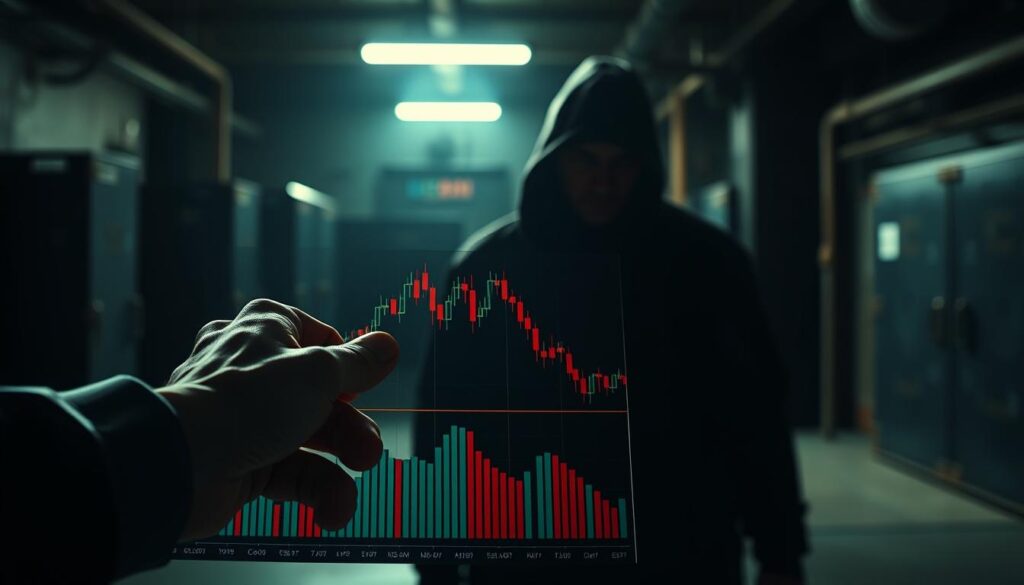Now Reading: Learn About Crypto Market Manipulation Tactics to Avoid
- 01
Learn About Crypto Market Manipulation Tactics to Avoid
Learn About Crypto Market Manipulation Tactics to Avoid

The digital asset landscape is exciting and fast-paced. Yet, its unique structure presents distinct challenges. This space often has less oversight than traditional finance.
Trading can be anonymous across many different platforms. This combination can create an environment where deceptive practices may flourish. Understanding these risks is the first step toward protection.
These deceptive actions aim to control or artificially change prices. This activity undermines trust and fairness. It can lead to significant losses for those who are unprepared.
Being aware of these schemes is crucial for anyone involved. Education empowers you to spot warning signs. For a deeper look at specific schemes, our guide on cryptocurrency market manipulation offers valuable insights.
Key Takeaways
- The digital asset environment has features that can make it easier for deceptive practices to occur.
- Artificial price influence harms market integrity and can impact investor returns.
- Awareness and knowledge are your primary defenses against these sophisticated schemes.
- These practices often exploit both technical vulnerabilities and human psychology.
- Staying informed helps you navigate this space with greater confidence and security.
Understanding Cryptocurrency Market Manipulation
The architecture of blockchain-based financial networks introduces novel challenges for maintaining fair trading conditions. These digital ecosystems differ significantly from traditional finance in their operational framework.
Deceptive practices in this space aim to artificially influence asset values. They create false impressions about supply and demand dynamics. This undermines the natural price discovery process.
The Importance of Market Integrity
Market integrity forms the foundation of trust in any financial system. Without transparent trading practices, investors cannot make informed decisions. They face elevated risks when price signals become distorted.
The pseudonymous nature of blockchain transactions complicates detection efforts. Perpetrators can operate across fragmented exchanges with relative impunity. This makes tracing harmful activities particularly difficult.
Regulatory enforcement in digital asset spaces still lags behind traditional markets. While agencies like the SEC have increased their focus, comprehensive oversight remains limited. Protecting market integrity requires both regulatory action and individual vigilance.
Understanding these dynamics helps investors navigate the landscape more safely. Proper cryptocurrency market analysis based on news becomes essential for identifying genuine opportunities amidst potential deception.
Recognizing Common Manipulation Tactics in Crypto Markets
Several deceptive practices have become alarmingly common in digital asset trading. Understanding these schemes helps investors spot dangerous situations before committing capital.
Wash Trading and Spoofing Explained
Wash trading involves repeatedly buying and selling the same asset. This creates artificial volume that misleads other participants.
Traders use multiple accounts they control for this activity. The goal is to trigger FOMO by making an asset appear more active.
Spoofing works differently. Manipulators place large orders with no intention of executing them. This false demand or supply influences prices before orders get canceled.
Identifying Pump-and-Dump Schemes
Pump-and-dump schemes rely on social media hype. Coordinated groups artificially inflate prices through aggressive promotion.
They then sell their holdings once prices peak. This causes dramatic crashes that leave late investors with significant losses.
In 2023 alone, over 90,000 tokens were flagged for this activity. These schemes generated an estimated $241.6 million in illicit profits.
Smaller assets with low liquidity are particularly vulnerable. Watch for sudden volume spikes without real news behind them.
Effective Strategies: crypto market manipulation tactics to avoid
Real-world examples provide the clearest window into how manipulative operations function. Learning from these events helps you spot warning signs before they impact your portfolio.

Identifying Red Flags in Trading Activity
Stay alert for unusual patterns. A sudden volume spike without major news is a classic red flag.
Watch order books for large walls that vanish before execution. This spoofing tactic creates false pressure.
Sharp price moves during quiet hours often signal low liquidity being exploited. Real movements usually have clear reasons.
Learning from Historical Cases
The Ishan Wahi case was a landmark. It involved insider information about new exchange listings.
In the FTX case, leaders used large purchases to artificially boost a token’s value. This shows even prominent platforms can be involved.
The Mango Markets example involved exploiting a price feed. A trader manipulated oracle data to gain millions.
Binance.US claimed to prevent wash trades. Yet, its own market maker engaged in that very activity. Always verify an exchange’s claims.
These lessons are vital. They teach us to be skeptical and always check the data behind the hype.
Exploring Wash Trading, Spoofing, and Order-Book Manipulation
Three sophisticated trading schemes frequently distort digital asset valuations through artificial activity. These methods create false signals that mislead participants about genuine supply and demand.

Case Examples from Leading Exchanges
Wash trading involves simultaneous buy and sell orders for the same asset. Traders control multiple accounts to create artificial volume without changing ownership.
Some major platforms have faced allegations of this practice. Their own market-making entities sometimes engage in manipulative wash trading activities.
Spoofing uses large buy or sell orders that get canceled before execution. These “walls” create false impressions of demand or supply pressure.
Impact on Trading Volumes and Liquidity
Artificial volume from wash trading misrepresents true market depth. This can cause significant slippage when legitimate traders execute large orders.
Order-book manipulation like layering places multiple small orders at different prices. This creates momentum illusions that trick other participants.
Exchanges with weak oversight are particularly vulnerable to these schemes. Careful analysis of trading patterns helps detect suspicious activity.
Influence of 24-Hour Global Markets on Manipulative Practices
Round-the-clock financial platforms operate without traditional closing bells, creating windows of vulnerability. This continuous structure allows participation from across the world at any time.
The constant operation spreads trading activity thin across many hours. This creates periods of significantly reduced liquidity when fewer participants are active.

Regulatory Challenges in Continuous Trading
Monitoring activity across multiple time zones presents significant hurdles. Different jurisdictions have varying oversight capabilities and enforcement resources.
Historical cases from other 24-hour markets provide important lessons. The Forex scandal involved traders coordinating large orders during specific 60-second windows.
These manipulators targeted benchmark rates used worldwide. Similarly, the LIBOR scandal showed how banks could collude across global markets.
Digital asset exchanges face similar or greater risks. They combine continuous trading with pseudonymous participants and fragmented platforms.
Investors should exercise particular caution during off-peak hours. Lower liquidity periods present elevated risk of price distortion and higher volatility.
The Role of Decentralized Finance and Smart Contracts
The promise of permissionless trading in DeFi comes with a unique set of vulnerabilities that manipulators are quick to exploit. Unlike centralized platforms, these systems operate through automated smart contracts.
This automation removes human intermediaries but also creates new attack surfaces. Flaws in contract code or reliance on external data can be disastrous.

Smart Contract Vulnerabilities
Smart contracts execute trades and loans based on pre-set rules. If these rules have bugs or loopholes, they can be manipulated.
This can lead to significant loss of digital assets. Choosing well-audited protocols is a critical defense against this fraud.
Oracle Manipulation and Sandwich Attacks
Many contracts need external price feeds called oracles. Manipulating this data is a serious threat.
The Mango Markets case is a stark example. A trader manipulated an oracle’s price data to illicitly gain $115 million.
Another common method is the sandwich attack. A manipulator spots a large pending trade on a decentralized exchange.
They buy the asset just before the trade, inflating the price. They then sell immediately after, profiting from the artificial demand they created.
| Vulnerability Area | Centralized Platforms | DeFi Platforms |
|---|---|---|
| Primary Risk | Internal bad actors, exchange hacks | Smart contract bugs, oracle failures |
| Execution Speed | Human-dependent, can be slower | Instant, automated, and irreversible |
| Investor Recourse | Potential for customer support | Often limited; “code is law” |
Understanding these differences is key to navigating the space safely. The automated nature of DeFi can amplify losses if manipulation occurs.
Harnessing Data Analytics and Expert Insights
Modern detection systems combine blockchain transparency with artificial intelligence to identify suspicious activity. These technologies analyze massive amounts of trading data that would overwhelm human analysts.
Experts use sophisticated methods to uncover hidden patterns. They examine transaction timing, volume spikes, and order book symmetry.
Leveraging Blockchain Transparency for Detection
Blockchain’s permanent record provides a valuable forensic tool. Every transaction remains visible on the public ledger for investigation.
While addresses are pseudonymous, skilled analysts can trace asset flows. They uncover connections between seemingly unrelated accounts through pattern recognition.
Advanced systems use machine learning to flag potential fraud in real-time. These algorithms detect wash trading, spoofing, and coordinated trading across multiple wallets.
| Detection Method | Manual Analysis | Automated Systems |
|---|---|---|
| Data Processing Capacity | Limited to small datasets | Handles millions of transactions |
| Pattern Recognition | Relies on human intuition | Uses algorithmic pattern matching |
| Response Time | Days or weeks | Real-time alerts |
| Detection Accuracy | Variable based on expertise | Consistent across large datasets |
Individual investors benefit from understanding these detection capabilities. This knowledge helps them choose platforms with robust monitoring systems.
Transparent projects with regular audits provide safer trading environments. Data-driven analysis continues to improve detection effectiveness.
Risk Management Strategies for Crypto Investors
Proactive measures form the foundation of secure participation in digital asset ecosystems. Smart investors develop comprehensive strategies to protect their capital.
Mitigating Losses During Market Volatility
Volatile periods require careful planning. Use limit orders to control entry and exit prices. This prevents unexpected slippage.
Stop-loss orders cap potential losses. They automatically sell assets when prices drop below set levels. This protects against sudden crashes.
Avoid excessive leverage during uncertain times. High leverage amplifies both gains and losses. It increases vulnerability to rapid price movements.
Practical Tips for Trading in Low-Liquidity Periods
Low liquidity creates higher risk. Trading activity slows during off-peak hours. This makes assets easier to manipulate.
Reduce position sizes when liquidity is thin. Be patient with order execution. Consider avoiding trading altogether during these windows.
| Trading Scenario | High-Liquidity Approach | Low-Liquidity Approach |
|---|---|---|
| Order Type | Market orders acceptable | Strictly limit orders |
| Position Size | Standard allocation | Reduced by 50-70% |
| Execution Speed | Immediate fills expected | Extended wait times |
These strategies help investors navigate challenging conditions. For deeper risk management strategies, explore additional resources.
Conclusion
Navigating the complex world of digital assets requires constant awareness of sophisticated threats that can impact investment outcomes. From traditional wash trading and spoofing to emerging DeFi exploits, these practices exploit technological, regulatory, and psychological vulnerabilities across global markets.
Investors must remain vigilant by focusing on assets with transparent liquidity and verified fundamentals. Always verify social media hype with on-chain data and prioritize reputable platforms. Applying risk management strategies like diversification and cautious trading during low-liquidity periods provides essential protection.
While regulatory frameworks continue evolving, personal responsibility remains crucial. Informed investors who recognize warning signs in trading activity can successfully participate in cryptocurrency markets. Ongoing education about emerging schemes empowers you to protect your investments in this rapidly changing financial landscape.
FAQ
What is wash trading in cryptocurrency markets?
Wash trading is a deceptive practice where a trader simultaneously buys and sells an asset to create misleading, artificial activity. This fraud inflates trading volumes and can manipulate the price, tricking other investors into believing there is high demand.
How can I spot a potential pump-and-dump scheme?
Look for sudden, unexplained price surges accompanied by intense social media hype from private groups. These dump schemes often target assets with low liquidity. Be wary of “can’t miss” signals and pressure to buy quickly before a coordinated sell-off causes significant losses.
What is spoofing, and how does it work?
Spoofing involves placing large buy or sell orders with no intention of executing them. The goal is to create a false impression of supply or demand to influence other traders. The spoofer then cancels these orders once the market price moves in their desired direction, a clear market manipulation tactic.
Are decentralized exchanges (DEXs) immune to these manipulative practices?
No, DEXs are not immune. While they operate differently, risks like sandwich attacks—where bots exploit pending transactions—and oracle manipulation exist. The decentralized finance world still faces challenges with these sophisticated strategies that can impact asset prices.
What are some red flags in trading data that suggest manipulation?
Key red flags include abnormally high trading volumes on a specific platform with little price movement, repetitive patterns of large orders being placed and canceled, and significant price changes during low-liquidity periods. Analyzing this data can help identify suspicious activity.
How can investors protect themselves from these tactics?
Investors should use reputable exchanges, diversify their portfolios, and avoid FOMO (fear of missing out) buying. Conduct thorough research, be skeptical of unrealistic promises, and consider using stop-loss orders to help mitigate potential losses from volatile price swings caused by fraudulent schemes.











